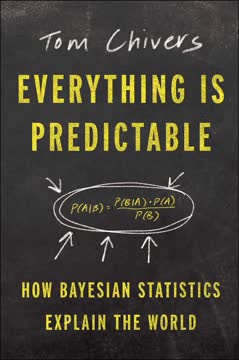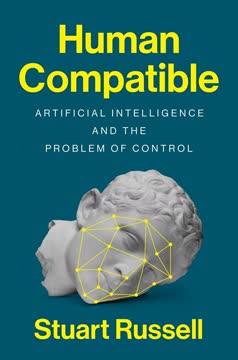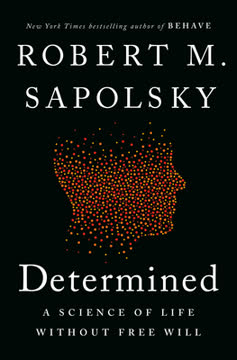Key Takeaways
1. Watched People Are Nice People: Social monitoring, real or perceived, encourages prosocial behavior.
Watched people are nice people.
Social surveillance. The mere feeling of being observed, whether by actual people or implied by cues like eyes or cameras, significantly increases prosocial behavior. This is a fundamental human tendency, rooted in our evolutionary history, where reputation and social standing were crucial for survival.
Examples of social monitoring:
- Drivers slow down when they see a police car.
- Shoppers are less likely to steal when there are security cameras.
- People are more generous when donating in public.
- Even subtle cues, like images of eyes, can increase generosity.
Supernatural monitoring. This basic social intuition is the foundation for the idea of supernatural watchers. If being watched by humans makes us nicer, then the belief in a God who sees all can encourage cooperation even when no one else is watching. This is a key mechanism by which religion promotes prosocial behavior.
2. Religion is Situational, Not Just Personal: Religious behavior is more about context than inherent belief.
Religion is more in the situation than in the person.
Situational salience. Religious behavior is not solely determined by a person's inherent religiosity but is heavily influenced by the immediate context. Reminders of God, religious settings, and rituals can trigger prosocial behavior, even in those who are not deeply religious.
Examples of situational influence:
- Christians are more charitable on Sundays, when religious reminders are more salient.
- Muslims are more generous during the call to prayer.
- Hindus are less selfish when playing economic games in a temple.
- Religious priming (subliminal exposure to religious words) increases generosity.
Competing motivations. Religious motivations compete with other goals and values. Religious beliefs only impact behavior when they become salient at the moment of temptation. This explains why even devout believers don't always act according to their religious principles.
3. Hell is Stronger Than Heaven: Fear of punishment is a more potent motivator than the promise of reward.
Hell is stronger than heaven.
Punishment vs. reward. The fear of divine punishment is a more effective deterrent of antisocial behavior than the promise of divine reward. Belief in a wrathful, punishing God is more likely to encourage prosocial behavior than belief in a kind, forgiving God.
Evidence for this claim:
- Believers who see God as mean are less likely to cheat.
- Priming a punishing God reduces stealing, while priming a forgiving God does not.
- Nations with higher belief in hell have lower crime rates.
- Believers who see God as punitive are less likely to punish others, as they offload this duty to God.
Psychological mechanisms. The fear of punishment is a more immediate and powerful motivator than the promise of reward, which is often seen as distant and uncertain. This is why the threat of hell is a more effective tool for social control than the promise of heaven.
4. Trust Those Who Trust in God: Shared belief in a higher power fosters trust and cooperation.
Trust people who trust in God.
Religious signals. Shared belief in a higher power serves as a signal of trustworthiness, allowing believers to cooperate with each other more readily. This is because those who believe they are being watched by a moralizing God are more likely to behave prosocially.
Evidence for this claim:
- People are more likely to trust those who are perceived as religious.
- Believers are more likely to trust other believers.
- Religious responders in economic games are more likely to reciprocate trust.
- Religious groups often form trade networks based on shared faith.
Bounded trust. This trust is often bounded by religious affiliation. Believers are more likely to trust those who share their faith, and less likely to trust those who do not. This can lead to distrust of atheists, who are seen as lacking a moral compass.
5. Actions Speak Louder Than Words: Extravagant religious displays signal genuine commitment.
Religious actions speak louder than words.
Credibility-enhancing displays (CREDs). Extravagant religious behaviors, such as self-sacrifice, fasting, and costly rituals, serve as credible signals of genuine commitment to a religious group. These displays are hard to fake, making them reliable indicators of true belief.
Examples of CREDs:
- Self-castration among priests of Cybele.
- Self-scarification in the Thaipusam festival.
- Fasting and pilgrimage in Islam.
- Martyrdom in various religious traditions.
Cultural transmission. These displays not only signal commitment but also transmit beliefs to others. When people witness others engaging in costly religious behaviors, they are more likely to adopt those beliefs themselves. This is a key mechanism for the cultural spread of prosocial religions.
6. Unworshipped Gods Are Impotent: Belief alone is insufficient; cultural support and commitment are crucial.
Unworshipped Gods are impotent Gods.
Belief vs. commitment. It's not enough to simply believe in a god; passionate commitment and cultural support are crucial for a deity to become a powerful force in a society. Many supernatural concepts exist, but only a few become objects of worship.
Examples of this principle:
- Mickey Mouse and Santa Claus are not gods, despite having supernatural qualities.
- Zeus, once a powerful god, is now a figure of myth.
- The gods of other religions are often seen as fictional by outsiders.
Cultural transmission. The key difference is that worshipped gods are backed by public displays of commitment, while fictional characters are not. These displays signal that the belief is genuine and important, making it more likely to be adopted by others.
7. Big Gods for Big Groups: Prosocial religions with powerful, moralizing gods facilitate large-scale cooperation.
Big Gods for Big Groups.
Scaling up cooperation. Big Gods, who are omniscient, powerful, and morally concerned, are more prevalent in larger, more complex societies. These deities facilitate cooperation among strangers by acting as supernatural monitors and enforcers of social norms.
Evidence for this claim:
- Hunter-gatherer societies typically lack moralizing gods.
- Big Gods become more common as societies become larger and more hierarchical.
- Societies with chronic water shortages are more likely to have moralizing gods.
- The rise of Big Gods coincides with the rise of agriculture and large-scale settlements.
Cultural evolution. The cultural evolution of Big Gods is a response to the challenges of large-scale cooperation. As groups grow, traditional mechanisms of social control become less effective, and supernatural monitoring becomes a necessary tool for maintaining social order.
8. Religious Groups Cooperate to Compete: Intergroup conflict drives internal cohesion and religious expansion.
Religious groups cooperate in order to compete.
Intergroup competition. Prosocial religions are not just about internal cooperation; they also foster group solidarity that allows them to compete with rival groups. This competition can take the form of warfare, economic competition, or demographic expansion.
Evidence for this claim:
- Groups with strong social solidarity are more likely to win in intergroup conflicts.
- Men are more likely to support wars and volunteer to fight when their group is under threat.
- Costly rites are more common in societies with frequent warfare.
- Religious groups with high levels of commitment are more likely to expand and outcompete rivals.
Cultural selection. The cultural selection of prosocial religions is driven by the fact that these groups are better able to mobilize their members for collective action, allowing them to outcompete rival groups. This process has led to the spread of prosocial religions throughout the world.
9. Religion Can Both Create and Resolve Conflict: Religious beliefs can both fuel and mitigate intergroup hostility.
Religious groups cooperate in order to compete.
Double-edged sword. Religion can be a source of both cooperation and conflict. While it promotes social cohesion within groups, it can also exacerbate hostility and violence between groups.
Pathways to conflict:
- Supernatural monitoring creates boundaries between "us" and "them."
- Religious participation can increase support for violence against outgroups.
- Sacred values make conflicts less tractable and compromise more difficult.
Pathways to peace:
- Religious participation can also promote tolerance and inclusiveness.
- Reframing sacred values can open new doors for conflict resolution.
- Religious leaders can play a role in promoting peace and reconciliation.
Context matters. The impact of religion on conflict depends on the specific context, including the nature of the conflict, the beliefs and practices of the religious groups involved, and the presence of other factors that can either exacerbate or mitigate conflict.
10. Secularism is a Product of Religion: Secular societies often emerge by replacing religious functions with secular institutions.
Secular societies climbed the ladder of religion, and then kicked it away.
Secular alternatives. Secular societies, with their strong institutions and rule of law, have found ways to maintain large-scale cooperation without relying on religion. These institutions, such as courts, police, and contract-enforcing mechanisms, have taken over some of the functions previously performed by religion.
Evidence for this claim:
- Secular societies, such as those in Scandinavia, have high levels of trust and cooperation.
- Reminders of secular authority can increase prosocial behavior.
- Strong secular institutions erode religious belief.
- Secular ideologies often borrow from religious concepts.
Interchangeable functions. Gods and governments can be seen as interchangeable sources of external control and stability. When people have faith in their government, they are less likely to rely on religion. This is why secular societies often emerge in places where government is strong and effective.
11. Multiple Paths to Disbelief: Atheism arises from various factors, not just a rejection of religious belief.
Unworshipped Gods are impotent Gods.
Varieties of atheism. Atheism is not a monolithic phenomenon. There are multiple pathways to disbelief, each with its own psychological roots. These include:
- Mind-blind atheism: Deficits in mentalizing make it difficult to conceptualize a personal God.
- Analytic atheism: Habitual analytic thinking undermines intuitive religious beliefs.
- Apatheism: Indifference to religion due to existential security.
- InCREDulous atheism: Lack of exposure to credible displays of religious commitment.
Interconnected pathways. These pathways are not mutually exclusive. They can interact and reinforce each other, leading to a variety of different forms of disbelief. For example, analytic thinkers may be more likely to be drawn to science, which in turn further undermines their religious beliefs.
Atheism as a cultural phenomenon. Atheism is not simply the absence of belief; it is a cultural phenomenon that is shaped by a variety of psychological, social, and historical factors. Understanding these factors is crucial for understanding the rise of secularism in the modern world.
Last updated:
FAQ
What's Big Gods: How Religion Transformed Cooperation and Conflict about?
- Exploration of Religion's Role: The book examines how belief in "Big Gods" has influenced human cooperation and conflict throughout history.
- Cultural Evolution Framework: It presents a framework linking the rise of moralizing gods to the development of large-scale societies.
- Interplay of Morality and Religion: Discusses how morality and religion have become intertwined, especially in larger societies.
Why should I read Big Gods by Ara Norenzayan?
- Insight into Human Behavior: Offers a unique perspective on the psychological and social mechanisms underpinning human cooperation and conflict.
- Interdisciplinary Approach: Combines anthropology, psychology, and history to explore the evolution of religious beliefs.
- Relevance to Modern Society: Addresses the role of religion in social cohesion and conflict, relevant to contemporary debates.
What are the key takeaways of Big Gods?
- Supernatural Monitoring: Belief in watchful deities encourages prosocial behavior and cooperation.
- Cultural Evolution of Religion: Religion evolves with cultural changes, with Big Gods emerging to support social cohesion in larger groups.
- Religious Actions Matter: Visible commitment to beliefs fosters group solidarity and cooperation.
How does Ara Norenzayan define "Big Gods" in Big Gods?
- Powerful and Moralizing Deities: Big Gods are deities concerned with human morality, monitoring behavior and enforcing standards.
- Contrast with Local Spirits: Differ from local spirits of smaller societies, which are less powerful and indifferent to human affairs.
- Cultural Adaptation: Seen as a cultural adaptation to challenges posed by larger, more anonymous social groups.
How does Big Gods explain the evolution of cooperation?
- Cultural Solutions to Cooperation: As groups expanded, Big Gods emerged as a solution to facilitate cooperation among diverse groups.
- Role of Supernatural Monitoring: Belief in omniscient gods encourages cooperation by deterring selfish actions through fear of punishment.
- Historical Context: Provides historical examples to illustrate how religions facilitated cooperation among diverse populations.
What psychological mechanisms does Norenzayan discuss in Big Gods?
- Theory of Mind: Cognitive ability to understand others as intentional agents, foundational for forming beliefs about gods.
- Social Surveillance: Feelings of being watched enhance prosocial behavior, even in anonymous situations.
- Cognitive Biases: Explores how cognitive predispositions shape religious beliefs and influence social interactions.
What are the Eight Principles of Big Gods in Big Gods?
- Watched People Are Nice People: Belief in a watchful deity encourages prosocial behavior.
- Religion Is More in the Situation Than in the Person: Situational reminders of religious beliefs can influence behavior more than personal beliefs alone.
- Hell Is Stronger Than Heaven: Fear of divine punishment is a stronger motivator for moral behavior than the promise of rewards.
- Trust People Who Trust in God: Believers are more likely to trust others who share their faith.
What role do rituals play in Big Gods?
- Credibility-Enhancing Displays: Rituals serve as public demonstrations of commitment to a faith, reinforcing group solidarity.
- Cultural Transmission: Engaging in rituals helps transmit religious beliefs and practices across generations.
- Social Cohesion: Rituals foster a sense of belonging and community, essential for prosocial religions.
How does Big Gods relate to modern secular societies?
- Decline of Religion: Discusses how secular institutions can replace the social functions of religion, leading to cooperation without supernatural beliefs.
- Trust in Institutions: In societies with strong secular institutions, trust levels can be high, reducing the need for religious belief as a moral source.
- Cultural Evolution: Suggests that as societies evolve, mechanisms once reliant on religious belief can be supplanted by effective governance and social norms.
What are the best quotes from Big Gods and what do they mean?
- "Watched people are nice people.": Belief in a watchful deity encourages altruistic behavior, even in anonymous situations.
- "Hell is stronger than heaven.": Fear of punishment is a more powerful motivator for moral behavior than the promise of rewards.
- "Unworshipped Gods are impotent Gods.": Without visible devotion, a deity's influence diminishes, affecting the religion's ability to foster community.
How does Big Gods address the issue of religious hypocrisy?
- Religious Actions vs. Words: Emphasizes that actions demonstrating commitment to a faith are more important than verbal declarations.
- Guarding Against Impostors: Prosocial religious groups must be vigilant against those who fake belief to exploit resources.
- Cultural Mechanisms: Extravagant displays of faith can safeguard against hypocrisy, ensuring only sincere believers are part of the community.
What evidence does Norenzayan provide for his claims in Big Gods?
- Cross-Cultural Studies: Analyzes data from various societies to show how beliefs in moralizing gods correlate with social complexity.
- Historical Examples: Uses historical examples to illustrate how religious beliefs evolved alongside societal changes.
- Anthropological Insights: Highlights differences between small-scale societies and larger ones, examining the role of local spirits versus Big Gods.
Review Summary
Big Gods receives mixed reviews, with praise for its thought-provoking ideas on religion's role in societal cooperation. Many appreciate the scientific approach and compelling arguments. Critics find the writing dense and repetitive, suggesting it could be condensed. Some question the methodology and potential bias. The book explores how "Big Gods" enabled large-scale cooperation and the evolution of religious beliefs. Readers appreciate insights into atheist distrust and secular alternatives to religion, though some find certain sections less engaging.
Similar Books










Download PDF
Download EPUB
.epub digital book format is ideal for reading ebooks on phones, tablets, and e-readers.




